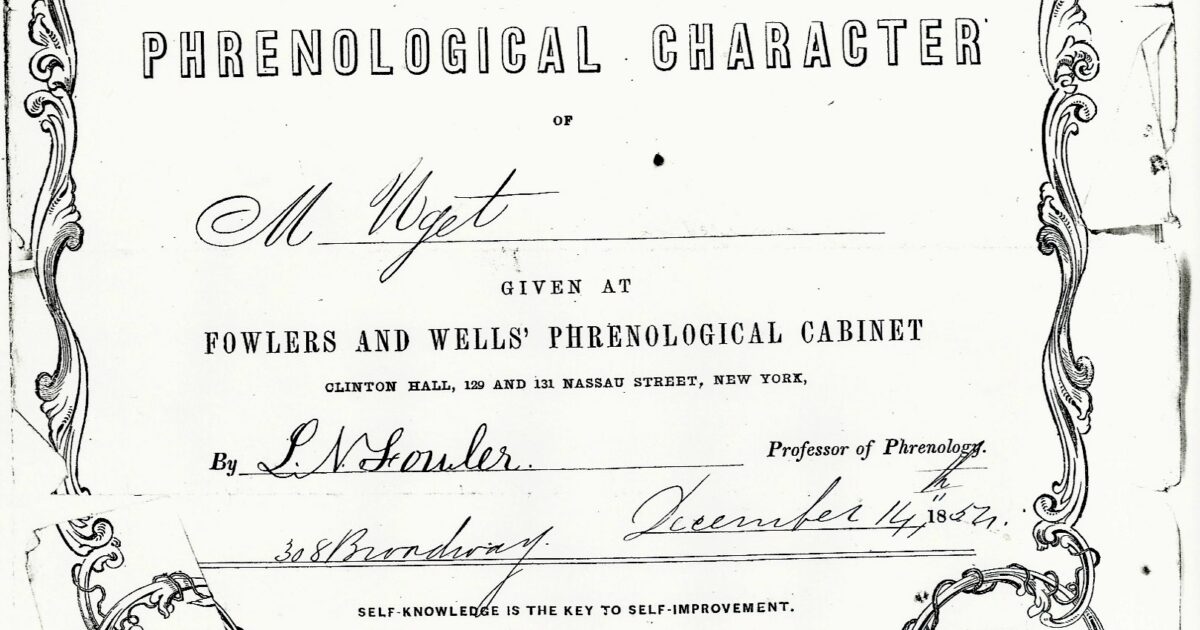Science
Uugaq’s Unusual Encounter with Phrenology in 1854 New York

In December 1854, Uugaq, an Inuk hunter, made a remarkable visit to the Fowlers and Wells’ Phrenological Cabinet in New York City. This encounter was part of a broader trip to the United States, where he was exposed to various aspects of American culture and science. His examination by Dr. Fowler, a prominent phrenologist, offers a glimpse into the beliefs and practices of a pseudoscience that was widely accepted in the 19th century.
Phrenology, developed in Germany by Franz Joseph Gall around 1800, posited a connection between the mind’s attributes and the shape of an individual’s head. Phrenologists believed that different areas of the brain corresponded to specific personality traits and behaviors. By “reading bumps” on the skull, practitioners claimed they could assess a person’s character, emotional tendencies, and even propensities for criminal behavior. While this practice was once fashionable, it is now widely discredited.
During his visit on December 14, 1854, Uugaq was described as having a head structure similar to that of a European, a statement reflecting the racial theories of the time. Dr. Fowler’s report indicated that Uugaq was “less savage, revengeful and cruel, than the North American Indian,” a characterization that reveals the biases inherent in phrenological assessments. The report further elaborated on his personality, noting that Uugaq possessed qualities of affection and family devotion, suggesting he had a stronger attachment to family than was typical among Indigenous peoples, according to the standards of the era.
Dr. Fowler’s observations continued with insights into Uugaq’s cognitive and emotional attributes. He noted that Uugaq was “slow in maturing” but demonstrated perseverance in his endeavors. Interestingly, Fowler pointed out that Uugaq was ambitious and sensitive to others’ opinions, yet lacked certain attributes like dignity and self-love. These dichotomous descriptions illustrate the contradictory nature of phrenological assessments, which often reflected the prejudices and misconceptions of the time.
The report also mentioned Uugaq’s perceptual abilities, claiming he had a good memory for forms and places but struggled with colors and events. Fowler even ventured into the realm of physical traits, stating that Uugaq had “better digestion than the white man,” showcasing the absurdity of phrenological claims that extended beyond personality into physical attributes.
After concluding his unusual examination, Uugaq returned to Groton, Connecticut, to spend Christmas with Sidney O. Budington, a veteran whaler. This visit marked a brief respite before Uugaq’s return to the Arctic. On April 11, 1855, he reboarded the Georgiana with Budington, heading back to Frobisher Bay, where he was reunited with his family.
This episode in Uugaq’s life not only highlights the peculiarities of 19th-century science but also serves as a reflection of the attitudes toward Indigenous peoples during that period. It underscores how pseudoscientific practices like phrenology were intertwined with cultural perceptions, often leading to misrepresentations and stereotypes that persist in some forms today.
Kenn Harper, a historian who lived in the Arctic for over 50 years, provides context to these events in his column, “Taissumani,” which revisits significant historical occurrences. Harper is the author of notable works such as “Give Me Winter, Give Me Dogs: Knud Rasmussen and the Fifth Thule Expedition” and “Thou Shalt Do No Murder.” His insights into Uugaq’s journey remind readers of the complexities of cultural exchanges in history and the lasting impact of misguided scientific beliefs.
-

 Science3 months ago
Science3 months agoToyoake City Proposes Daily Two-Hour Smartphone Use Limit
-

 Top Stories3 months ago
Top Stories3 months agoPedestrian Fatally Injured in Esquimalt Collision on August 14
-

 Health3 months ago
Health3 months agoB.C. Review Reveals Urgent Need for Rare-Disease Drug Reforms
-

 Technology3 months ago
Technology3 months agoDark Adventure Game “Bye Sweet Carole” Set for October Release
-

 World3 months ago
World3 months agoJimmy Lai’s Defense Challenges Charges Under National Security Law
-

 Lifestyle3 months ago
Lifestyle3 months agoVictoria’s Pop-Up Shop Shines Light on B.C.’s Wolf Cull
-

 Technology3 months ago
Technology3 months agoKonami Revives Iconic Metal Gear Solid Delta Ahead of Release
-

 Technology3 months ago
Technology3 months agoApple Expands Self-Service Repair Program to Canada
-

 Technology3 months ago
Technology3 months agoSnapmaker U1 Color 3D Printer Redefines Speed and Sustainability
-

 Technology3 months ago
Technology3 months agoAION Folding Knife: Redefining EDC Design with Premium Materials
-

 Business3 months ago
Business3 months agoGordon Murray Automotive Unveils S1 LM and Le Mans GTR at Monterey
-

 Technology3 months ago
Technology3 months agoSolve Today’s Wordle Challenge: Hints and Answer for August 19









